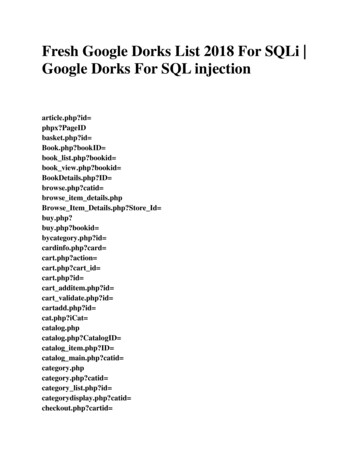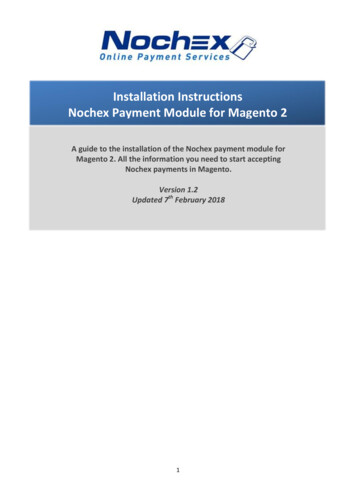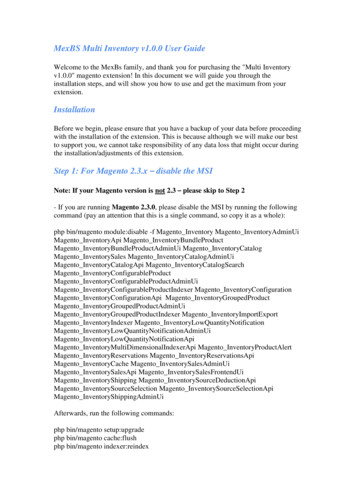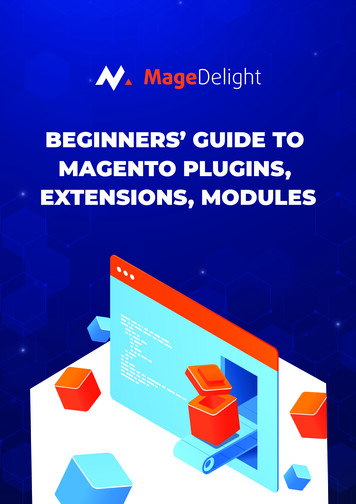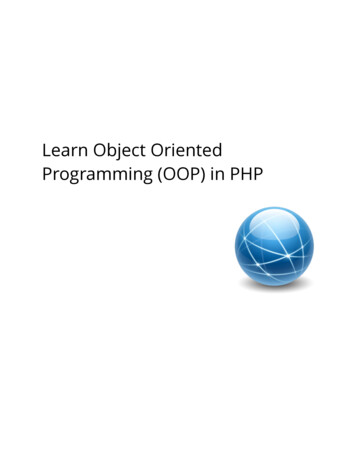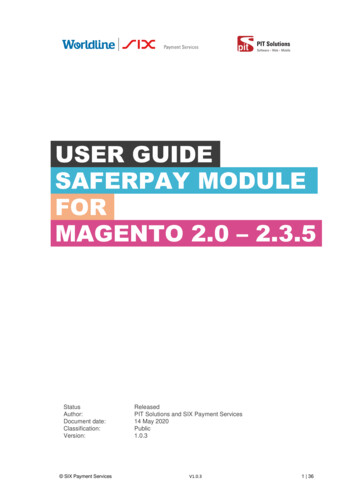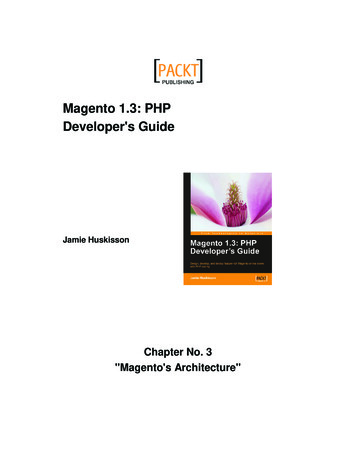
Transcription
Magento 1.3: PHPDeveloper's GuideJamie HuskissonChapter No. 3"Magento's Architecture"
In this package, you will find:A Biography of the author of the bookA preview chapter from the book, Chapter NO.3 " Magento's Architecture "A synopsis of the book’s contentInformation on where to buy this bookAbout the AuthorJamie Huskisson, a passionate 23-year-old freelance developer from Nottingham, hasbeen working with Magento for the past two years since the very early BETA versions.His development client list features names such as NHS, Volkswagen, and Nike with hisday-to-day work life spent building everything from web applications to e-commercestores and small business sites. He also trains groups of developers, and providesconsulting on adopting open source technologies over closed systems for clients whenrequired.Jamie also writes and maintains a popular online blog athttp://www.jhuskisson.com/ where he gives advice on various aspects of the web,including freelancing, Magento, Wordpress, PHP, and running your own business.For More opers-guide/book
I'd like to thank my girlfriend Vicky for putting up with my latenights working on the book. I'd also like to thank my family andespecially my mother, for raising me to believe that I can achieveanything I put my mind to.To everyone that reads this, enjoy your time developing what youread in and out of this book. I look forward to hearing from any ofyou that develop sites or modules based on what you read betweenthese covers.For More opers-guide/book
Magento 1.3: PHP Developer'sGuideMagento 1.3: PHP Developer's Guide will guide you through development with Magento,an open source e-commerce platform. Exploring commonly approached areas of Magentodevelopment, Magento 1.3: PHP Developer's Guide provides you with all the informationyou'll need to get a very solid understanding of developing with Magento.What This Book CoversChapter 1, Magento 3.1: PHP Developer's Guide shows you what this book will coverentirely in detail for you to read through.Chapter 2, Installing/Upgrading Magento and Preparing for Development will prepareyou for development with Magento as well as showing you how to install and upgradeMagento using a variety of different methods.Chapter 3, Magento's Architecture introduces you to Magento's architecture, the Zendframework, and how the system works from a development point of view.Chapter 4, Shipping Modules in Magento shows you how to put together shippingmodules in Magento to handle shipping calculation and information.Chapter 5, Building a Payment Module for Magento guides you in putting togetherpayment methods in Magento and building connecting modules between Magento andthe payment gateway of your choice.Chapter 6, Building a Basic Featured Products Module walks you through building afeatured product module into your web site so that you can show featured products inyour Magento categories.For More opers-guide/book
Chapter 7, Fully-Featured Module for Magento with Admin Panel shows you how to puttogether a fully featured module in Magento as well as giving it a full backend to managedata with. You'll also learn how to use the module creator to quickly deploy moduleskeletons to use yourself in the future.Chapter 8, Integration of Third-Party CMS will show you how to integrate Wordpresswith your Magento installation. It will also show you the other options available shouldyou use any other content management systems.Chapter 9, Magento's Core API guides you through the Magento Core API and how toutilize it with scripts of your own to interface with Magento's data.Chapter 10, Importing and Exporting Data shows you how to work with import andexport data profi les in Magento to work with basic order, product, and customer data.Appendix, Resources for Further Learning, contains additional resources for furtherlearning. Its not a part of this book and it can be downloaded from Packt's uces-for-Further-Learning. pdf.For More opers-guide/book
Magento's ArchitectureMagento has a wonderful architecture behind its system. It's a very strict architecturethat relies on us knowing where the files should be placed and how to structure ourtemplates and modules. But this is part of what makes Magento a great system, inthat it enforces these standards.Here in this chapter, we will learn about this architecture and how it applies todevelopment with Magento. We will learn: Where everything is within Magento What all the base directory files and folders do The basics of how the template system works How modules work within the system How the Zend Framework fits into the equation The best methods for backing up MagentoMagento's base structureThe fundamental knowledge of Magento's architecture begins with its file structure.It's important to know what goes where by default, so that we may position ournew files accordingly, especially in terms of ensuring that our development doesn'toverwrite core files.For More opers-guide/book
Magento's ArchitectureBase directoryThe default installation contains the following files and directories in thebase directory: .htaccess 404 (directory) app (directory) downloader (directory) js (directory) lib (directory) media (directory) pkginfo (directory) report (directory) skin (directory) var x.phpindex.php.sampleLICENSE AFL.txtLICENSE.txtpearEach of these files and directories has a different purpose. We'll go through themto ensure that we understand the function of each. This will help us later, if everwe need to find something specific, or when developing. It will also be helpfulwhen we'll be looking to place the files coming out of our new module into theappropriate directory.[ 38 ]For More opers-guide/book
Chapter 3The function of each of the files in the basedirectoryThe following is a run through of all the files in the base directory, to show us whatthey do: .htaccess—This file controls mod rewrite for fancy URLs and setsconfiguration server variables (such as memory limit) and PHP maximumexecution time, so that Magento can run better. .htaccess.sample—Works as a backup for .htaccess, so that we knowthe default .htaccess file (if ever we edit it and need to backtrack). cron.php—The file that should be executed as a cron job every fewminutes to ensure that Magento's wide caching doesn't affect ourserver's performance. favicon.ico—Magento's default favicon; it's the small icon that appearsin the toolbar of our browser. index.php—The main loader file for Magento and the file thatinitializes everything. index.php.sample—The base template for new index.php files, usefulwhen we have edited the index.php file and need to backtrack. LICENSE AFL.txt—It contains the Academic Free License that Magentois distributed under. LICENSE.txt—It contains the Open Software License that Magento isdistributed under. pear—This controls all automatic updating via the downloader and SSH.This file is initialized and handles the updating of each individual modulethat makes up Magento. php.ini—A sample php.ini file for raw PHP server variablesrecommended when setting up Magento on our server. This should not beused as a complete replacement, but only as a guide to replace certain linesof the php.ini server file. It is useful when overriding these variables when.htaccess isn't enabled on our server.[ 39 ]For More opers-guide/book
Magento's ArchitectureThe function of each of the folders in the basedirectoryThe following is a run through of all the folders in the base directory to show ustheir contents: 404—The default 404 template and skin storage folder for Magento. app—All code (modules), design (themes), configuration, and translationfiles are stored in this directory. This is the folder that we'll be workingin extensively, when developing a Magento powered website. Alsocontained in this folder are the template files for the default administrationtheme and installation. downloader—The web downloader for upgrading and installing Magentowithout the use of SSH (covered in Chapter 2). js—The core folder where all JavaScript code included with the installationof Magento is kept. We will find all pre-compiled libraries of JavaScript here. lib—All PHP libraries used to put together Magento. This is the core codeof Magento that ties everything together. The Zend Framework is also storedwithin this directory. media—All media is stored here. Primarily for images out of the box, thisis where all generated thumbnails and uploaded product images will bestored. It is also the container for importing images, when using the massimport/export tools (that we'll go through in Chapter 10). pkginfo—Short form of package information, this directory contains textfiles that largely operate as debug files to inform us about changes whenmodules are upgraded in any way. report—The skin folder for the reports that Magento outputs when anyerror occurs. skin—All assets for themes are stored within this directory. We typicallyfind images, JavaScript files, CSS files, and Flash files relating to themes,in this directory. However, it can be used to store any assets associatedwith a theme. It also contains the skin files for the installation of skins andadministration templates. var—Typically where we will find all cache and generated files for Magento.We can find the cache, sessions (if storing as files), data exports, databasebackups, and cached error reports in this folder.[ 40 ]For More opers-guide/book
Chapter 3The template system architectureThe template architecture is broken into three areas—two for development of thetheme and one for the containment of the assets: /app/design/frontend/default/ template name / layout/—For all the XML files declaring which module tiedfunctions should be called to which template files template/—For all the templates processing the output thatis passed from functions called from layout/ and structuredinto the final output to the user./skin/frontend/default/ template name /—For the containmentof all assets relating to our template, images, CSS, Flash, and JavaScript.Structural blocks and content blocksEach theme contains structural and content blocks. Structural blocks are the onesthat lay out the theme into sections. Let's take a look at a three-column layout.The following are the structural blocks in a three-column layout: header left content right footer[ 41 ]For More opers-guide/book
Magento's ArchitectureHere's a visual representation of those structural blocks laid over the Magentodemo store:In each of the structural blocks, we then have content blocks that give each structuralblock its content for output to the browser. Let's take the right column; our contentblocks set for this column on a standard theme could be: mini cart recently viewed products newsletter subscription block poll[ 42 ]For More opers-guide/book
Chapter 3Here we have a visual representation of these content blocks on top of the Magentodemo store:On receiving a request from a user connecting to our site to view the page:1. Magento will load the structural areas2. Each structural area will be processed through3. Magento will gather the content blocks assigned to each structural area4. It will then progress through the content block template for each structuralarea, to process the output5. It sends all of this back as final output to the user, who then views theMagento page that was requested[ 43 ]For More opers-guide/book
Magento's ArchitectureXML layout filesTo assign blocks to each of these structural blocks, Magento loads an XML layout filefor each request. This XML layout file is called by the URL that the user is accessingon the site. It declares all modules that are to be loaded in each structural area of thesite. On top of this, we have a page.xml file, which is the default loader for all pageson the site.A layout XML file is typically structures as follows: default reference name "header" block type "page/html header" name "header" as "header" block type "page/template links" name "top.links"as "topLinks"/ block type "page/switch" name "store language"as "store language"template "page/switch/languages.phtml"/ block type "core/text list" name "top.menu" as "topMenu"/ /block /reference /default In the above code, we have: default —The handler for the URL, in this case default will load no matterwhat other handler is being initialized reference —The reference structure which calls the blocks in our theme block —A content block which defines the type of block and the templatewhich will process the block's outgoing data in the systemIn addition to this, Magento uses actions within blocks for functions which need toprocess the data that is input to them, for example adding CSS stylesheets: block type "page/html head" name "head" as "head" action method "addCss" stylesheet css/menu.css /stylesheet /action action method "addCss" stylesheet css/clears.css /stylesheet /action [ 44 ]For More opers-guide/book
Chapter 3 action method "addItem" type js /type name varien/iehover-fix.js /name params/ if lt IE 7 /if /action action method "addCss" stylesheet css/print.css /stylesheet params media "print" /params /action action method "addCss" stylesheet css/print.css /stylesheet params media "print" /params /action /block We'll notice that there are several tags within the action method tag. These areprocessed into an array and then passed through the action method "" parameter,in this case addCss. This function then places the input into an output, ready for itsappropriate template.Layouts are fully explained online in Magento's designer guide:http://www.magentocommerce.com/design guide/articles/intro-to-layouts.Hierarchical file processingWhen creating new themes, we do not have to worry about copying all the themeand skin files from the default theme over to our new one. Let's presume that wehave an additional theme called new theme, alongside our default theme. Ourtheme calls files called logo.gif and image.gif on one of its pages.[ 45 ]For More opers-guide/book
Magento's ArchitectureThe themes that we have contain the following files in their skin's images directory:defaultlogo.gifimage.gifnew themelogo.giftest.gifMagento would process this main requesting logo.gif and image.gif. Asnew theme is our current active theme, it will pull logo.gif from there., However,as image.gif does not exist in new theme, Magento would grab that from default.So now, it works like this:Requested filelogo.gifimage.gifTheme it will come fromnew themedefaultSimilarly, if test.gif were called in our template then it would come from thedefault theme. If we upload an image called test.gif to the image directory ofnew theme, then it would immediately come from there instead.This applies to all files for themes in Magento, which include the following: Templates Layout XML files Anything in the theme skin foldersMagento's template architecture and hierarchy is also explained onlinein the designer's guide to Magento: http://www.magentocommerce.com/design guideModules and how they work within thesystemMagento primarily works on a base of modules. All functionality is divided upinto modules that make up the system overall. It's important to understand whateach module does and how to go about adding modules to the system, in order tounderstand the architecture of modules themselves.[ 46 ]For More opers-guide/book
Chapter 3Distribution of the modules betweendirectoriesAll modules are located within the /app/code/ directory. Directories are commonlyreferred to as codePools. There are three possible locations for all modules thatrelate to the system. They are all split by type to prevent any confusion: community—For community-distributed extensions, usually those that wehave installed through Magento Connect or have downloaded from a source,other than our own. Anything installed through Magento Connect will beinstalled here automatically. core—Reserved for core Magento modules, so that we cannot directlyoverwrite or interfere with them. We keep our modules out of core to avoidany conflict with the core modules or any future updates. Anything from aMagento upgrade or any new Magento modules will go into this directory. Local—This is where we should be placing our modules when they areeither under local development or are not distributed among the community.It's best to keep anything that we develop in this directory, so as to notinterfere with the core or community modules. Nothing will be automaticallyinstalled here, unless we have physically uploaded it.Modules included with MagentoIncluded modules in the core folder of default Magento installation are as follows: Mage AdminMage AdminNotificationMage ApiMage BackupMage BundleMage CatalogMage CatalogIndexMage CatalogInventoryMage CatalogRuleMage CatalogSearchMage CheckoutMage CmsMage ContactsMage Core[ 47 ]For More opers-guide/book
Magento's Architecture Mage CronMage CustomerMage DataflowMage DirectoryMage DownloadableMage EavMage GiftMessageMage GoogleAnalyticsMage GoogleBaseMage GoogleCheckoutMage GoogleOptimizerMage InstallMage LogMage MediaMage NewsletterMage PageMage PaygateMage PaymentMage PaypalMage PaypalUkMage PollMage ProductAlertMage RatingMage ReportsMage ReviewMage RssMage RuleMage SalesMage SalesRuleMage SendfriendMage ShippingMage SitemapMage TagMage Tax[ 48 ]For More opers-guide/book
Chapter 3 Mage UsaMage WeeeMage WishlistSetting up the folder structure of a moduleLet's presume that we want to set up a module's folder structure, readyfor development. Our module's core folders will be placed in /app/code/local/Book/Example/.These folders will primarily be used for storing our code that makes the modulework. The folder structure breaks down as follows: Block/controllers/etc/Model/ Mysql4/Book/sql/ book setup/Typically, developers will pick or choose each folder, depending on whether ornot they're going to use it within their module.Note that Model/Mysql4/Book/ has its first letter in uppercase, whereassql/book setup/ does not. We must be sure to keep this the same way throughoutour development.Template files for the frontend of our module will be stored as follows: XML files will be stored in /app/design/frontend/ interface / theme /layout/example/ Output files will be stored in /app/design/frontend/ interface / theme /template/example/Any admin template files for the frontend of our module will be stored as follows: XML files will be stored in /app/design/adminhtml/ interface / theme /layout/example/ Output files will be stored in /app/design/adminhtml/ interface / theme /template/example/[ 49 ]For More opers-guide/book
Magento's ArchitectureHere's a breakdown of what each folder is for: Block/—For processing of all display blocks called by the system for themodule. These are controllers that will be called in the XML layout fileswithin a theme, in order to display something. controllers/—Our controllers that support the application and structurallykeep things together. etc/—Configuration files for the module, for declaring things such as thedefault options when installed and declaring all blocks, models, and install/upgrade actions. Model/—For placement of all models to support controllers in the module. sql/—SQL actions when the module is installed/upgraded/uninstalled.Zend Framework and its role withinMagentoMagento (at its raw PHP base) is built on the Zend Framework. From the databaseclass to the handling of URLs, Magento is in its raw form, with Zend Frameworkdoing all the work. Alongside this, Varien has built several core modules on top ofthe Zend Framework, in order to tie it altogether into the system as we know it.What is Zend FrameworkZend Framework's official site best describes the framework as follows:Zend Framework (ZF) is an open source framework for developing web applicationsand services with PHP 5. ZF is implemented using 100% object-oriented code. Thecomponent structure of ZF is somewhat unique; each component is designed withfew dependencies on other components. This loosely coupled architecture allowsdevelopers to use components individually. We often call this a "use-at-will" design.[ 50 ]For More opers-guide/book
Chapter 3While they can be used separately, Zend Framework components in the standardlibrary form a powerful and extensible web application framework when combined.ZF offers a robust, high performance MVC implementation, a database abstractionthat is simple to use, and a forms component that implements HTML form rendering,validation, and filtering so that developers can consolidate all of these operationsusing one easy-to-use, object-oriented interface. Other components, such asZend Auth and Zend Acl, provide user authentication and authorization against allcommon credential stores. Still others implement client libraries to simply access tothe most popular web services available. Whatever your application needs are, you'relikely to find a Zend Framework component that can be used to dramatically reducedevelopment time with a thoroughly tested foundation.How Zend Framework worksThe Zend Framework (at its core) is designed to be used as a package or separatemodules. This (among other features) makes it unique, as most other frameworksare designed to be used plainly as frameworks or not at all.However, the Zend Framework comes with classes that allow us to use it as astandalone framework and develop with it as one. Instead of being delivered with apreset amount of directories and layout for developers, it only suggests a layout forour files. This means that we can adapt the framework to meet our current workflowand choose how much we adapt the workflow to fit the framework.It's role and effect in MagentoThe Zend Framework allows Magento to focus on the core issues at hand. It removesa lot of the work on the database and core structural classes and puts the worktowards fixing and adding to core modules of Magento.Most importantly it gives developers a standard approach to development that theycan move across and apply to Magento. The standard development practices helpgreatly in adopting Magento as a platform and make it easier for developers havingexperience with Zend Framework to adapt to Magento.More information on learning the Zend Framework and resources can befound at the back of this book in the Appendix attached. Its official site islocated at: http://framework.zend.com/.[ 51 ]For More opers-guide/book
Magento's ArchitectureBacking up Magento's dataIt's important to know how to back up our site, to ensure that our installation's datais not lost (if ever things go bad).It is recommended to back up our Magento installation: Regularly as a base to ensure that there are incremental backupsof our system Before installing new modules or themes from Magento Connect When developing modules Before upgrading our systemBacking up the filesWe will need to back up all the files relating to the Magento installation, whenbacking up our system. Two of the ways in which this can be done are given below.ManuallyManually, we are able to download all the files of the installation to our harddrive. This is the longest method of backing up the files and is the most foolproofmethod available.Using SSHUsing SSH, we're able to vastly speed up the duration of backing up the servers.We can do this in two ways: Zipping up all files, if the server has it enabled Copying all files to another directoryBoth of these depend on whether or not our server has SSH. So if this isn't availableto us, then we cannot use these methods.[ 52 ]For More opers-guide/book
Chapter 3Both of these methods require us to connect to our server via SSH firstand then use the cd command to get to the directory (which Magento isinstalled in), before running the commands.Zipping up all filesThis will create a zip file of our entire Magento installation's files and folders calledmagento archive.zip.tar cf magento archive.tar *To untar this archive, extract the files afterwards:tar -xvf yourfilename.tarWe can then move this to another directory of our choice using the mv command:mv magento archive.zip /path/to/new/destination/Copying all files to another directoryWe run the following command to copy all files (as they are) into another directoryon our server. We'll replace the full path with the path to the desired directory, intowhich we want to copy all the files.cp –R * /path/to/new/destination/Backing up the databaseWe'll need to back up the database as part of our Magento backup. Let's gothrough how.[ 53 ]For More opers-guide/book
Magento's ArchitectureUsing the system itselfMagento comes with a built-in method for backing up our installation and keepingseveral backups logged, in case we want to download older backups at any time. Itcan be found in the System menu under Tools:The initial screen will be similar to the next screenshot:[ 54 ]For More opers-guide/book
Chapter 3To create a backup via the System panel, all we need to do is click on Create Backupin the upper-right of the screen and wait for it to finish:The process of creating a backup can take quite a while (especially for biggerdatabases), so we will need to keep an eye on our server's memory limits and PHPexecution limits. These are set in our .htaccess file on runtime, but some serverswill only run the defaults and not allow them to be overridden. If we encounter awhite screen instead of the success message (shown in the previous screen), thenthe problem is either memory limit or execution time limit. We will need to increasethem ourselves or contact our web host.Once the backup is completed, however, we'll be able to find it in our /var/backups/ folder. They will be named by timestamp and the highest numberedfilename will be the last to be backed up.Using phpMyAdminThe most common back up solution is phpMyAdmin, and some people prefer it overany built-in method. To export via phpMyAdmin, we:1. Navigate to the database2. Switch to the export tab3. Select all tables and SQL as the export type4. Under options on the right-hand side select Disable foreign key checks5. Select save as file at the very bottom of the page6. If we want to match the compression type of Magento's output, selectgzipped as our compression method7. Click the Go button to export[ 55 ]For More opers-guide/book
Magento's ArchitectureThis will give us an SQL file, which we can then import at a later date back into anempty database and restore our data.SummaryIn this chapter, we've learned the following: How Magento's folder structure and files are laid out What each of the base directory's folders and files do How the template system works How modules work within Magento About the Zend Framework and how it benefits Magento How best to go about backing up Magento and when to go about itFurther to this chapter, I want you to read the Magento designer's guide and theZend Framework documentation and examples. There are also a very good groupof links for you to read through in the Appendix at the back of this book. These willincrease your knowledge of the Magento architecture and benefit you throughoutthis book.[ 56 ]For More opers-guide/book
Where to buy this bookYou can buy Magento 1.3: PHP Developer's Guide from the Packt Publishing velopersguide/book.Free shipping to the US, UK, Europe and selected Asian countries. For more information, pleaseread our shipping policy.Alternatively, you can buy the book from Amazon, BN.com, Computer Manuals andmost internet book retailers.www.PacktPub.comFor More opers-guide/book
development, Magento 1.3: PHP Developer's Guide provides you withall the information you'll need to get a very solid understanding of developing with Magento. What This Book Covers Chapter 1, Magento 3.1: PHP Developer's Guideshows you what this book will cover entirely in detail for you to read through. Chapter 2, Installing/Upgrading Magento .
